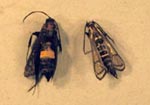|
Description
The female moth of the peach tree borer is dark blue with
a wide orange stripe around the abdomen. She has opaque front
wings and clear hind wings. The male is steel gray with yellow
markings and clear wings. The male and female moths of the
lesser peach tree borer have clear wings, and both are metallic
blue with yellow markings. The eggs of the lesser peach tree
borer are small, reddish-brown, and extremely hard.
|
Click on image for larger
version

Figure 1. Peach Tree Borer Larva
|
|
Click
on image for larger version

Figure 2. Peach Tree Borer Adults
|
The
larvae of both species are naked, grayish-to yellowish-white
caterpillars with brown heads. The length varies from very
small to about three-fourth inch for the lesser peach tree
borer and one inch for the peach tree borer. To spin a cocoon,
the mature larva makes a hollow space anywhere near the surface
in the wound area. Bits of frass, gum, or bark are attached
to the outside. The pupa is a light brown typical moth pupa.
|
Life
History
The larvae overwinter in whatever stage of growth they happen to
be when winter approaches. They may be very small or fully mature.
They begin to feed when the temperature warms up and grow as the
temperature rises during the summer. The mature larvae transform
into pupae from early spring to late July. In southern Illinois
the lesser peach tree borer moths emerge from late May to late September,
the greatest numbers appearing from mid-June to late July. The peach
tree borer moths emerge from mid-June to late September with the
greatest numbers appearing from mid-July to mid-August.
Since
moth emergence is also affected by temperature, it begins later
and occurs for a shorter time in northern Illinois than in the southern
section. The peach tree borer moth lays eggs at ground level on
the trunk of the tree, in cracks in the ground, or on bits of litter.
The lesser peach tree borer moth goes up and down the limbs seeking
rough bark or cracks in which to lay eggs. Particularly attractive
are wounds where gum is exuding and where borers are present. Eggs
hatch in 8 to 30 days, and the larvae attempt to bore into the bark.
To survive they must get under dead bark near live bark where they
have protection for feeding. The peach tree borer completes one
life cycle a year. The lesser borer completes about one and one-half
cycles a year.
Damage
Any wound on stone fruit trees may cause gum to exude. Borer damage
is usually attended by gumming, with varying amounts of frass in
the gum. The frass or fecal pellets look like fine sawdust. Peach
tree borer injury occurs a few inches either above or below the
ground. Lesser peach tree borer injury occurs particularly in peach
tree borer wounds but may also occur in any other spot above ground
where the larvae can get under dead bark. This may be where twigs
or branches have died and where mechanical wounds or winter injury
has occurred. The damage is caused by feeding of the larvae on the
growing inner bark. The wounds expand rapidly, and limbs or trunks
may be girdled. Open wounds permit entry of disease organisms that
may also kill live tissue or decay the heartwood. The peach tree
borer has long been an important pest; the lesser borer has been
important only in the past ten years.
|

